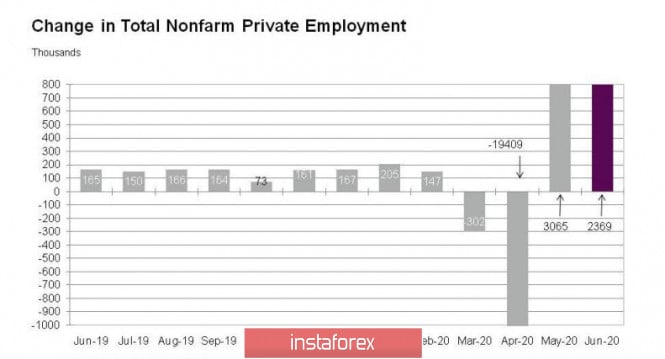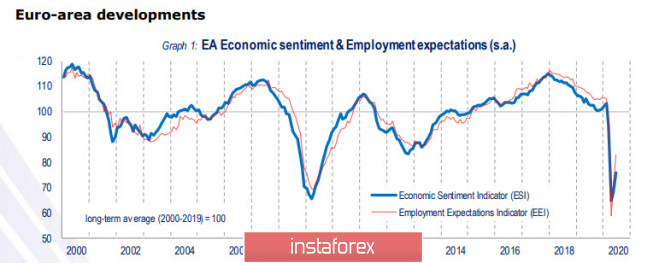Before the publication of the US labor market report in June, APD presented a report on private sector employment, which not only did not add clarity, but further confused the situation.
In June, 2369 thousand jobs were created, and this would have been an outstanding figure in the old days. But, first, 3 million new jobs were forecast, and second, the total after the failure in April created less than a third of the level of reduction, meaning the US economy is very far from the recovery zone.

In which areas of the economy has the recovery started? The answer to this question is discouraging – in fact, not yet in any. A small rebound is observed only in the service sector, which was able to work after the block, but in the physical economy, everything is not just bad – everything is catastrophically bad.
For example, the construction sector lost 2.499 million jobs in April-May, only 394 thousand were restored in June, or 15.8% of the pre-crisis level. Industry is even worse - 2.393 million jobs were lost, 88 thousand, or 3.8% of the pre-crisis level, were created in June. In fact, there are no signs of recovery yet, but there is only a reaction to the removal of restrictive measures.
At the same time, the ISM report states that the economy is expanding for the second month in a row after the April contraction – in June, the PMI index was 52.6%.
Only one conclusion can be drawn from published reports - the situation is extremely uncertain. Markets will wait for the publication of an employment report today, the reaction may be in any direction, depending on how much the data will differ from expectations. The dollar as of Thursday morning continues to be under pressure and so, there is no reason to expect its growth.
EUR/USD
Consumer prices rose in June by 0.3% y/y, exceeding expectations, the underlying index remained unchanged at 0.8% y/y. Low inflation is due to the significant effect of lower energy prices. Despite the weak growth rate, there are no signs of deflation, but this does not mean that the ECB does not see a threat. Last week, the ECB has already commented on this topic, recognizing that "inflationary expectations of market participants could become less reliable."
Currently, the ECB is focusing all its efforts on supporting the economy in order to quickly get out of the coronavirus crisis, which softens financial conditions, but after this task is solved, the focus will shift to inflationary expectations. There are several factors that will restrain price growth for some time - first of all, the cost of oil futures and strong growth in unemployment, but it is also worth noting the lack of clarity on how successfully the task of economic recovery is being addressed.
For example, the European Commission notes that there was a pullback from the lows in May, which, on the one hand, indicates a gradual recovery of the economy, and on the other, the pace of this recovery is too weak.

Markit, in turn, acknowledges that sentiment in the manufacturing sector remains lower than before the pandemic, and weak demand will slow recovery. Moreover, it does not exclude the possibility of the completion of a positive impulse.
A number of large banks are already expressing concerns that reducing inflation in the euro area to the negative area has serious preconditions, and that the ECB will be forced to take measures to support inflation in the near future.
EUR/USD pair is trading sideways pending US employment data. Chances for growth remain, the nearest goal is the resistance zone 1.1340/50 and further 1.1420.
GBP/USD
The pound is winning back the growth of positive expectations, as we expected earlier, consolidating above the resistance zone of 1.2410/20. The chances of successful completion of 1.2530/40 have increased, after which the next target 1.2700/20 will open, where the upper boundary of the medium-term downward channel passes. A successful test will give the bulls a second wind, as it will improve the technical picture, but there are no fundamental prerequisites for a strong growth of the pound yet, and the growth is due to only two factors – the weakness of the dollar and the growth of positive expectations for the global economy as a whole.
The material has been provided by InstaForex Company - www.instaforex.com